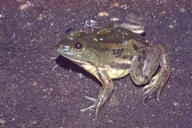|
Euphlyctis hexadactylus (Lesson, 1834)
Indian Five-fingered Frog, Indian Bullfrog (CITES) Subgenus: Phrynoderma | family: Dicroglossidae subfamily: Dicroglossinae genus: Euphlyctis |
 © 2011 Martin Pickersgill (1 of 9) |
|
|
|
Description Distribution and Habitat Country distribution from AmphibiaWeb's database: Bangladesh, India, Nepal, Sri Lanka
Life History, Abundance, Activity, and Special Behaviors Relation to Humans Possible reasons for amphibian decline Urbanization
References
Anders, C. (2002). Biologie und Systematik der Amphibien Nepals. Veröffentlichungen aus dem Fuhlrott-Museum, Wuppertal, Germany. Daniel, J. C. (2002). The Book of Indian Reptiles and Amphibians. Bombay National History Society, Delhi. De Silva, A., Molur, S., and Walker, S. (2000). CAMP Report for Amphibians and Reptiles of Sri Lanka. Conservation Breeding Specialist Group, Sri Lanka, Colombo, Sri Lanka. Dutta, S.K. and Manamendra-Arachchi, K. (1996). The Amphibian Fauna of Sri Lanka. Wildlife Heritage Trust of Sri Lanka, Colombo, Sri Lanka. Manamendra-Arachchi, K. (2000). ''Know your frog.'' Sri Lanka Nature, 2(5), 4-16. Schleich, H. H., and Kästle, W. (2002). Amphibians and Reptiles of Nepal. Koeltz Scientific Books, Koenigstein, Germany. Originally submitted by: peter janzen (first posted 2005-05-17) Edited by: Tate Tunstall (2005-09-06) Species Account Citation: AmphibiaWeb 2005 Euphlyctis hexadactylus: Indian Five-fingered Frog <https://amphibiaweb.org/species/4705> University of California, Berkeley, CA, USA. Accessed May 29, 2025.
Feedback or comments about this page.
Citation: AmphibiaWeb. 2025. <https://amphibiaweb.org> University of California, Berkeley, CA, USA. Accessed 29 May 2025. AmphibiaWeb's policy on data use. |


 Map of Life
Map of Life